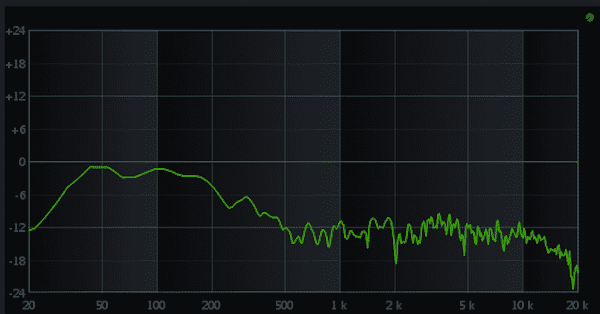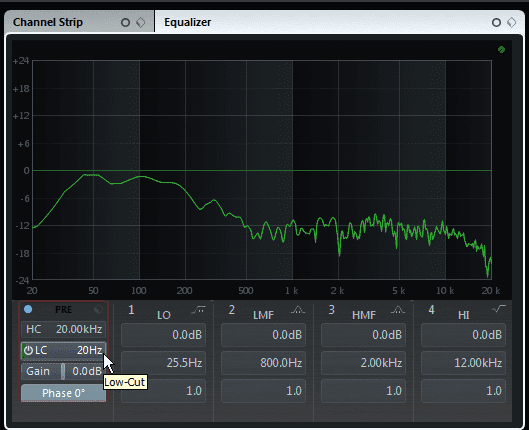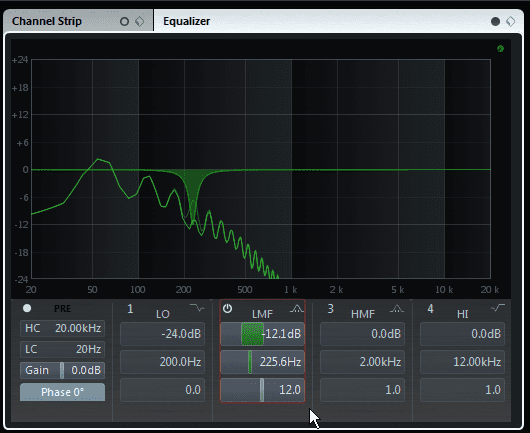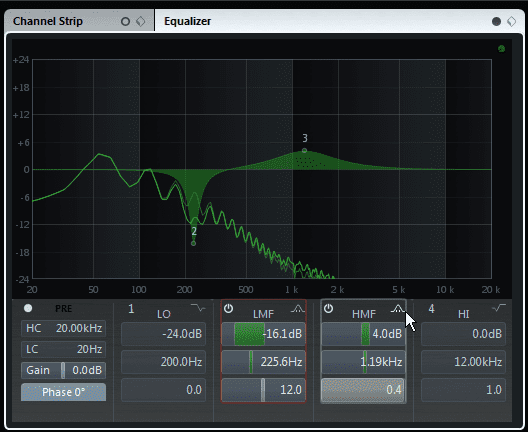5. EQ
As always with EQ, try to cut what you don’t want rather boost what you do. The rule is especially true of bass sounds as it’s easy to overdo the boost on bass – particularly if you’re listening on modest-sized monitors or in a less than acoustically perfect room (which, let’s be honest, applies to most of us).
Generally speaking, it’s best to use EQ to carve out extra space in the mix by removing unnecessary frequencies which clash with other elements. A good starting point is usually to cut the extreme low end on the kick drum with a high-pass filter before moving on to the bass itself:
Applying a heavy notch cut to the bass at about 250-300 Hz can help separate the mid-frequency elements from the low and make it easier for the kick and bass to work together:
On top of this, EQ can be used for tweaking the tone of the bass sound. Higher harmonics that provide richness or depth might benefit from a small but wide boost around 800-1200 Hz if you’re trying to bring out the definition of the bass part:
In fact, this can give the bass more apparent level and presence without resorting to EQing its fundamental (lowest) frequencies (which usually sit in the 40-160Hz area).
If you really feel that you need to boost in order to emphasise a particular frequency of the bass, be very careful about which EQ you use – some work better than others for this purpose, so it’s best to try a range of different plugins and pick whichever gives the best results. A dedicated tool like Little Labs’ Voice Of God (or the software emulation) might be the best option.
It’s worth reiterating the fact that you can only boost content that already exists in the signal: producers sometimes get confused as to why boosting higher frequencies is having little or no effect when the truth is the signal they’re treating has nothing in that range to boost.
EQing a sine wave and expecting something magical to happen is pure folly, as this example shows:
Boosting with EQ simply changes the gain:
In these kind of instances, you’ll need to introduce higher frequency content to the mix through layering or saturation/distortion.
Finally, don’t be lured into focussing on the bass in isolation when EQing – it’s essential to consider the mix as a whole. Removing low-frequency information from other elements helps create space for the bass without actually changing it.




08.15 PM
Nice article guys! I’m lovin Attack Magazine, in my opinion it’s the best website about electronic music 😉 thanks a lot! Cheers from Brazil
08.30 AM
I am really really enjoying the work you are doing with your articles!
Keep up the good work.
05.11 PM
I love these articles! I noticed that this lesson said it would teach us to make better basslines, but even though in the first page it saya that melody is one of the main things that needs to be considered; but there arent any specific tips in this article about choosing bassline notes! 🙂
I love you guys, can ya break that part down some more? Or do you just do the melody by ear?
07.04 PM
^ BIlly, I don’t want to be annoying but this article is one of the most complete I’ve ever seen on the internet. It’s kinda ungrateful to ask EVEN more about it… seriously :/
07.53 PM
@Billy, @Claudio…
No problems at all with the request…
It’s true that, of course, the melody plays a (the?) fundamental part in a successful bassline. This piece wasn’t about programming – but I certainly suggest reading the various Passing Notes pieces (http://www.attackmagazine.com/technique/passing-notes/) which are designed to give a good grounding in music theory, including the disco basslines piece (http://www.attackmagazine.com/technique/passing-notes/passing-notes-disco-house-basslines/) which has a lot of insights – even if you hate disco!
And, as ever, keep watching this space!
Dave@Attack
06.21 AM
Really helpful stuff, muchas gracias amigos!
10.02 PM
holycow. its difficult
on one dark-hand side i hope this page stays my my my own sweet little secret…. anyhow thanks for ur great work!!!
01.23 PM
This is a great article, thanks! However, the bass player plugin shows that there is no substitute for a real practiced human! Or a sample of one: but then of course you have to spend three months slicing and dicing ala Justice to keep the lawyers off your tail!
10.28 AM
hi, I own the tal u no lx but i cant find the mrs digit preset, does it come with it or is named something else?
Thanks!
11.11 AM
Luke – well spotted. We’re pretty sure the Mrs Digit patch is a Mr Fingers-inspired bass sound the writer created for the audio example. U-NO-LX is so simple that you should be able to copy the patch from the screengrab (although we had to increase the filter cutoff slightly to get the same sound).
If you’re looking for an even more accurate version of the classic Larry Heard sound, try the sub-oscillator on its own. Or you could use the pulse oscillator and set the pulse width manually to get a variety of slightly fuller or hollower sounds.
U-NO-LX is excellent for those 80s analogue bass sounds. We’re big fans.
http://www.attackmagazine.com/reviews/gear-software/tal-u-no-lx/
12.58 AM
Attack WE LOVE YOU.
03.37 PM
Thanks so much for this. Learning so much through your tutorials.
04.52 PM
very hot magazine! keep it coming
01.08 AM
this tutorial came in very handy for me, thank you attack people..very well written and it reminded me of some stuff i (probably) already had forgotten to consider again. big ups from vienna
02.28 AM
attack magazine thank you very much. very useful article .
08.28 PM
Awesome article. Thanks
12.47 AM
Another incredible article. Informative and clearly explained.
Attack is rapidly becoming my number one resource for production tips.
03.53 PM
Just got wind of this site. I will definitely be here more than ever. Really enlightening
08.22 PM
Just found this magazine, excellent well written articles. This one was excellent and covered lots of stuff. Ill be trying that notch on my bass eq real soon. Keep it up guys, great stuff
03.41 AM
If you’re using reverb on your bass, put the EQ before the reverb. It won’t matter so much for bass as for other instruments, but it will sound somewhat unnatural to have the reverb filtered.
01.36 PM
How have I missed this article? Great read as ever guys and very informative!
08.02 PM
great article but please for the love of god fix or change the sound player, its freezes after 2 seconds and never starts playing again, i have to refresh couple of times to even hear the whole soundclip
09.55 AM
I am new to this site and I must say the few articles I’ve read are quite good.
keep up the good work
12.55 AM
The best articles I’ve read in my life. Great work guys. Keep it up!
10.54 AM
Awesome tips—could u possibly provide the readers with a PDF version of the articles?
11.00 AM
amazing stuff guys……..really great content!
06.32 PM
Does this work on 808 bass?
12.16 AM
THIS IS SHIT
10.42 PM
Thanks for all of your excellent tutorials
06.04 PM
Nice article. I have just released a free youtube series on how to write bass lines too. Check it out!
https://www.youtube.com/watch?v=NHIHncaNaDw
02.55 PM
Any other software alternatives for the VOG plug-in you mentioned for boosting low-end?
Boz ‘Bark Of Dog’ resonant filter?
Tone2 Bifilter?
Any EQ like the Logic EQ or Pro-Q with a resonant low-shelf?
02.55 PM
oh, and great article btw. Attack Mag is fast becoming my favourite site for these tips and walkthroughs!
05.27 PM
Thanks! Best tutorial